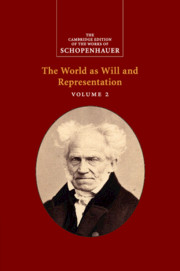Chapter 42 - Life of the Species
Published online by Cambridge University Press: 30 June 2022
Summary
In the previous chapter we recalled that the (Platonic) Ideas of the different levels of beings comprising the adequate objectivation of the will to life present themselves in individual cognition (which is bound to the form of time) as the species, i.e. as successive, similar individuals connected through the bonds of procreation, and that the species is therefore the Idea (eidos, species) that has been pulled apart by time. Accordingly, the essence in itself of every living thing lies primarily in its species: but the species, for its part, exists only in individuals. Although the will only achieves self-consciousness in the individual, and therefore cognizes itself immediately only in the individual, we nevertheless become conscious deep down that it is really the species in which its essence objectifies itself, since the affairs of the species as such, which is to say sexual relations, the procreation and nourishment of the young, are incomparably more important and urgent to the individual than any others. This explains rutting in animals (the vehemence of this is superbly described in Burdach's Physiology, vol. 1, §§ 247, 257), and in humans, the painstaking and capricious choice of another individual for the satisfaction of the sex drive, which can rise to the level of passionate love, and which I will describe more precisely in its own chapter: and finally, this explains the excessive love that parents have for their young.
In the supplements to the Second Book, the will was compared to the root and the intellect to the top of the tree: this is the case internally or psychologically. But externally or physiologically, the genitals are the root and the head is the crown. The intestinal villi of course are the nutritive principle, not the genitals: and it is not the villi but the genitals that are the root because they connect the individual to the species in which it is rooted. This is because the individual is physically a creation of the species, and metaphysically a more or less imperfect image of the Idea that presents itself under the form of time as the species. In agreement with the relation discussed here, the greatest vitality as well as decrepitude of the brain is simultaneous with that of the genitals and the two are connected.
- Type
- Chapter
- Information
- Schopenhauer: The World as Will and Representation , pp. 526 - 532Publisher: Cambridge University PressPrint publication year: 2018

